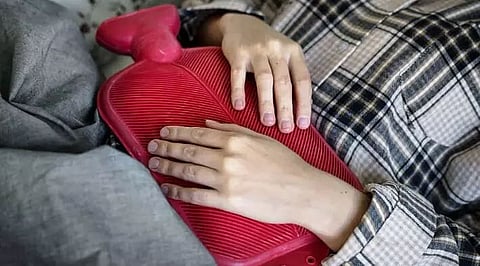
- Home
- Live Blog
- Breaking News
- Top Headlines
- Cities
- NE News
- Sentinel Media
- Sports
- Education
- Jobs

When we think of periods, the first thing that comes to our mind is the excruciating pain in the initial two days. It brings our everyday life to a standstill. According to gynecological experts, extremely painful periods are called dysmenorrhea but more than 90 percent women experiences pain, cramping and discomfort around the abdomen region due to uterine cramping.
The uterus releases the hormone prostaglandin during menstruation to kick start the process of uterine muscular contraction, informs Dr Sandeep Chadha, Consultant Obstetrician and Gynaecologist, Motherhood Hospital.
"Contractions happen at an immense rate and our body expels clots from the uterus during this time. However, if the pain is unbearable then major issues like fibroids and endometriosis could be to blame," he adds.
What are the causes of pain?
Dr. Chadha answers: Some people are just at a higher risk of having painful periods. These risks include:
Being under age 20, having a family history of painful periods, smoking, having heavy bleeding with periods, having irregular periods, never had a baby, reaching puberty before age 11, painful menstrual periods can also be the result of an underlying medical condition, such as:
Premenstrual syndrome (PMS): PMS is a common condition that's caused by hormonal changes in the body occurring 1 to 2 weeks before menstruation begins. Symptoms typically go away after bleeding begins.
Endometriosis: This is a painful medical condition in which cells from the lining of the uterus grow in other parts of the body, usually on the fallopian tubes, ovaries, or tissue lining the pelvis.
Fibroids in the uterus: Fibroids are noncancerous tumors that can put pressure on the uterus or cause abnormal menstruation and pain, though they often don't cause symptoms.
What can it be treated?
The expert suggests: To be free of pain, one can take OTC painkillers. Sometimes, at-home treatments can also do wonders in relieving painful menstrual periods. Using a heating pad on your pelvic area or back, massaging your abdomen, taking a warm bath, doing regular physical exercise and eating light and nutritious meals help a lot. One should not take caffeine during initial days of period because caffeine and sugar increase the chances of bloating. If the home remedies and pain killers can't offer much relief, then it's time to visit a gynaecologist. Unfortunately, her periods and the subsequent pain aren't going anywhere, but at least now the woman knows why it hurts so badly.
When to see a doctor?
If menstrual pain is interfering with your ability to perform basic tasks each month, it may be time to talk to a gyneacologist, Dr Chadha advises. Talk to your doctor about your symptoms and if you experience any of the following: Continuing pain after IUD placement, at least three painful menstrual periods, passing blood clots, cramping accompanied by diarrhea and nausea pelvic pain when not menstruating Sudden cramping or pelvic pain could be signs of infection. An untreated infection can cause scar tissue that damages the pelvic organs and may lead to infertility. (IANS)